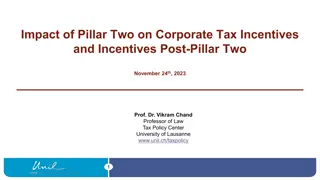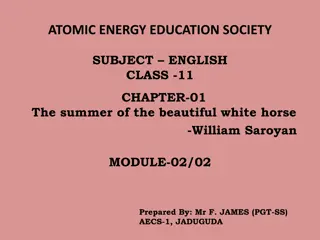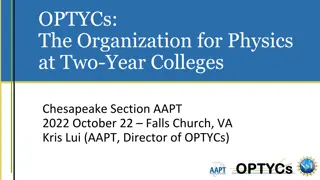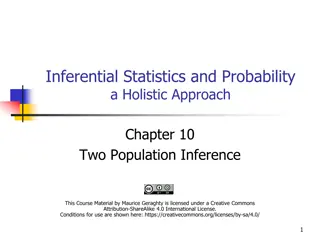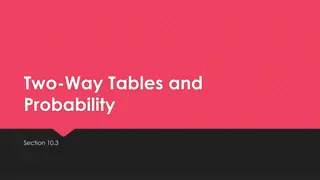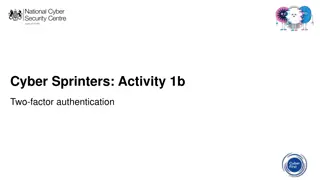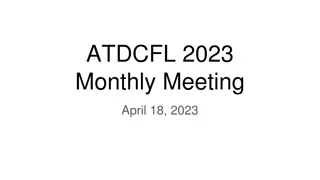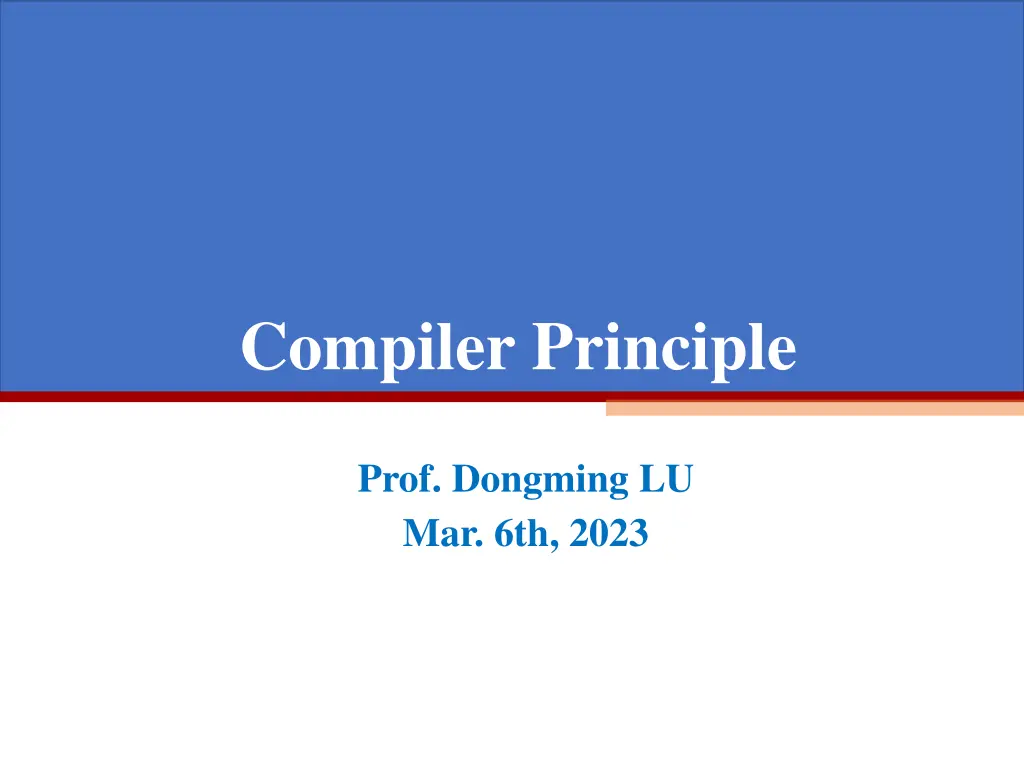
Understanding Compiler Principles and Lexical Analysis
Delve into the world of compiler principles with a focus on lexical analysis, parsing, abstract syntax, and semantic analysis. Explore the concept of finite automata and deterministic finite automaton (DFA) in the context of computer programming.
Download Presentation

Please find below an Image/Link to download the presentation.
The content on the website is provided AS IS for your information and personal use only. It may not be sold, licensed, or shared on other websites without obtaining consent from the author. If you encounter any issues during the download, it is possible that the publisher has removed the file from their server.
You are allowed to download the files provided on this website for personal or commercial use, subject to the condition that they are used lawfully. All files are the property of their respective owners.
The content on the website is provided AS IS for your information and personal use only. It may not be sold, licensed, or shared on other websites without obtaining consent from the author.
E N D
Presentation Transcript
Compiler Principle Prof. Dongming LU Mar. 6th, 2023
Content 1. INTRODUCTION 2. 3. 4. 5. LEXICAL ANALYSIS PARSING ABSTRACT SYNTAX SEMANTIC ANALYSIS 6. 7. ACTIVATION RECORD TRANSLATING INTO INTERMEDIATE CODE 8. OTHERS
A finite automaton A formalism Implemented as a computer program using finite automata (N.B. the singular of automata is automaton) Definition A finite set of states; Edges lead from one state to another, and each edge is labeled with a symbol One state is the start state, and certain of the states are distinguished as final states.
Figure 2.3: Finite automata for lexical tokens. The states are indicated by circles; Final states are indicated by double circles. The start state has an arrow coming in from nowhere. An edge labeled with several characters is shorthand for many parallel edges.
Deterministic Finite Automaton (DFA) No two edges leaving from the same state are labeled with the same symbol.
Deterministic Finite Automaton (DFA) A DFA accepts or rejects a string as follows. 1. Starting in the start state, for each character in the input string the automaton follows exactly one edge to get to the next state. 2. The edge must be labeled with the input character. 1. After making n transitions for an n-character string, if the automaton is in a final state, then it accepts the string. 2. If it is not in a final state, or if at some point there was no appropriately labeled edge to follow, it rejects. The language recognized by an automaton is the set of strings that it accepts.
An example Any string in the language recognized by automaton ID must begin with a letter. 1. Any single letter leads to state 2, which is final; so a single- letter string is accepted. 2. From state 2, any letter or digit leads back to state 2, so a letter followed by any number of letters and digits is also accepted.
DFA and RE In fact, the machines shown in Figure 2.3 accept the same languages as the regular expressions of Figure 2.2 if [a-z][a-z0-9]* [0-9]+ ([0-9]+"."[0-9]*)|([0-9]*"."[0-9]+) ("--"[a-z]*"\n")|(" "|"\n"|"\t")+ {return IF;} {return ID;} {return NUM;} {return REAL;} {/*do nothing*/} { error();} Figure 2.2 Figure 2.3
Combined finite automaton These are six separate automata; how can they be combined into a single machine that can serve as a lexical analyzer? ---- Ad hoc method!
Combined finite automaton Figure 2.4: Combined finite automaton
Combined finite automaton Labeling each final state with the accepted token-type State 2 has aspects of state 2 of the IF machine and state 2 of the ID machine; since the latter is final, then the combined state must be final. State 3 is like state 3 of the IF machine and state 2 of the ID machine; To disambiguate both final using rule priority to - labeling state 3 with IF because we want this token to be recognized as a reserved word, not an identifier
A transition matrix Encoding the above machine A two-dimensional array (a vector of vectors), subscripted by state number and input character. int edges[][] = { /* ...012...-...e f g h i j... */ /* state 0 */ {0,0,...0,0,0...0...0,0,0,0,0,0...}, /* state 1 */ {0,0,...7,7,7...9...4,4,4,4,2,4...}, /* state 2 */ {0,0,...4,4,4...0...4,3,4,4,4,4...}, /* state 3 */ {0,0,...4,4,4...0...4,4,4,4,4,4...}, /* state 4 */ {0,0,...4,4,4...0...4,4,4,4,4,4...}, /* state 5 */ {0,0,...6,6,6...0...0,0,0,0,0,0...}, /* state 6 */ {0,0,...6,6,6...0...0,0,0,0,0,0...}, /* state 7 */ {0,0,...7,7,7...0...0,0,0,0,0,0...}, /* state 8 */ {0,0,...8,8,8...0...0,0,0,0,0,0...}, et cetera }
A transition matrix Encoding the above machine A "dead" state (state 0) that loops to itself on all characters; to encode the absence of an edge. int edges[][] = { /* ...012...-...e f g h i j... */ /* state 0 */ {0,0,...0,0,0...0...0,0,0,0,0,0...}, /* state 1 */ {0,0,...7,7,7...9...4,4,4,4,2,4...}, /* state 2 */ {0,0,...4,4,4...0...4,3,4,4,4,4...}, /* state 3 */ {0,0,...4,4,4...0...4,4,4,4,4,4...}, /* state 4 */ {0,0,...4,4,4...0...4,4,4,4,4,4...}, /* state 5 */ {0,0,...6,6,6...0...0,0,0,0,0,0...}, /* state 6 */ {0,0,...6,6,6...0...0,0,0,0,0,0...}, /* state 7 */ {0,0,...7,7,7...0...0,0,0,0,0,0...}, /* state 8 */ {0,0,...8,8,8...0...0,0,0,0,0,0...}, et cetera } There is a "finality" array Mapping state numbers to actions - final state 2 maps to action ID, and so on.
RECOGNIZING THE LONGEST MATCH The job of a lexical analyzer : to find the longest match The lexer must keep track of the longest match with two variables Last-Final (the state number of the most recent final state encountered) Input-Position-at-Last-Final Every time a final state is entered, the lexer updates these variables A dead state (a nonfinal state with no output transitions) reached the variables tell what token was matched and where it ended.
Figure 2.5: The automaton of Figure 2.4 recognizes several tokens.
2.4 Nondeterministic Finite Automata
Nondeterministic Finite Automaton (NFA) A NFA: Have to choose one from the edges ( labeled with the same symbol -) to follow out of a state Have special edges labeled with (epsilon) An example of an NFA:
Nondeterministic Finite Automaton (NFA) The language recognized by this NFA All strings containing a multiple of two or three a's On the first transition This machine must choose which way to go? Must "guess !! And Always guess correctly!!
Nondeterministic Finite Automaton (NFA) Another NFA that accepts the same language Edges labeled with may be taken without using up a symbol from the input The machine must choose which -edge to take !! A state with some -edges and edges labeled by symbols Follow the corresponding symbol-labeled edge Or to follow an -edge instead
Why NFA? A (static, declarative) regular expression can be easy to be converted to a (simulatable, quasi-executable) NFA.
HOW CONVERTING A REGULAR EXPRESSION TO AN NFA? The conversion algorithm: Turning each regular expression into an NFA with a tail (start edge) and a head (ending state). For example: The single-symbol regular expression a
The regular expression ab: Combining the two NFAs Hooking the head of a to the tail of b In general, any regular expression M Some NFA with a tail and head:
The rules for translating regular expressions to nondeterministic automata Figure 2.6: Translation of regular expressions to NFAs.
The merged NFA for IF, ID, NUM, and error Figure 2.7: Four regular expressions translated to an NFA Each expression is translated to an NFA, The "head" state marked final with a different token type The tails of all the expressions joined to a new start node
WHY CONVERTING AN NFA TO A DFA Implementing deterministic finite automata (DFAs) as computer programs is easy
To avoid guesses by trying every possibility at once Figure 2.7: Four regular expressions translated to an NFA. Simulating the NFA of Figure 2.7 on the string in
Starting in state 1 Instead of guessing which -transition to take, the NFA might take any of them It is in one of the states {1, 4, 9, 14}; That is, the -closure of {1} No other states reachable without eating the first character
Making the transition on the character i From state 1 to reach 2; from 4 to 5, from 9 to nowhere, and from 14 to 15 So the set {2, 5, 15}. Again compute the -closure From 5 there is an -transition to 8 and From 8 to 6 So the NFA in one of the states {2, 5, 6, 8, 15}.
On the character n {2, 5, 6, 8, 15}. Get from state 6 to 7, from 2 to nowhere, from 5 to nowhere, from 8 to nowhere, and from 15 to nowhere. So the set {7}; its -closure is {6, 7, 8}.
Formally define -closure as follows 1. Let edge(s, c) be the set of all NFA states reachable by following a single edge with label c from state s. 2. For a set of states S, closure(S) is the set of states that can be reached from a state in S without consuming any of the input, that is, by going only through -edges. Mathematically, express the idea of going through -edges by saying that closure(S) is the smallest set T such that
Calculating T by iteration T can only grow in each iteration The final T must include S. T must also include The algorithm must terminate, because there are only a finite number of distinct states in the NFA.
Simulating an NFA as described above Suppose a set d = {si; sk; sl} of NFA states si; sk; sl. Starting in d and eating the input symbol c, reaching a new set of NFA states called set DFAedge(d; c) The NFA simulation algorithm more formally using DFAedge If the start state of the NFA is s1, the input string is c1, , ck, The algorithm is
Manipulating sets of states is expensive Costly to do on every character in the source program Do all the sets-of-states calculations in advance. Making a DFA from the NFA Each set of NFA states corresponds to one DFA state The NFA has a finite number n of states The DFA will have a finite number (at most 2n) of states.
DFA construction with closure and DFAedge algorithms. The DFA start state d1 is just closure(s1) There is an edge from di to dj labeled with c if dj = DFAedge(di, c). Let be the alphabet, DFA construction is as follows:
A state d is final in the DFA if any NFA state in states[d] is final in the NFA Labeling a state final is not enough Also say what token is recognized Several members of states[d] are final in the NFA Label d with the token-type that occurred first in the list of regular expressions How rule priority is implemented. After the DFA is constructed The "states" array may be discarded The "trans" array is used for lexical analysis.
Not visit unreachable states of the DFA In principle the DFA has 2nstates But only about n of them are reachable from the start state. To avoid an exponential blowup in the size of the DFA interpreter's transition tables
Applying the DFA construction algorithm to the NFA of Figure 2.7 gives the automaton in Figure 2.8 Figure 2.8: NFA converted to DFA This automaton is suboptimal: not the smallest one that recognizes the same language
The equivalent states Two states s1and s2are equivalent The machine starting in s1accepts a string if and only if starting in s2it accepts . Such as the states labeled {5,6,8,15} and {6,7,8} in Figure 2.8, and of the states labeled{10,11,13,15} and {11,12,13} . Figure 2.8: NFA converted to DFA In an automaton with two equivalent states s1and s2 Make all of s2's incoming edges point to s1instead and delete s2
How can we find equivalent states? Certainly, s1 and s2 are equivalent if they are both final or both nonfinal and, for any symbol c, trans[s1, c] = trans[s2, c]; {10,11,13,15} and {11,12,13} satisfy this criterion. This condition is not sufficiently general; consider the automaton Here, states 2 and 4 are equivalent, but trans[2, a] trans[4, a].
2.5 Lex: A Lexical Analyzer Generator
DFA construction A mechanical task easily performed by computer An automatic lexical-analyzer generator to translate regular expressions into a DFA Lex: A lexical analyzer generator that produces a C program from a lexical specification.
%{ /* C Declarations:*/ #include tokens.h /*definition of IF, ID ,NUM, */ #include errormsg.h union {int ival; string sval; double fval;} yylval; Int charPos=1 #define ADJ (EM_tokPos=charPos, charPos+=yyleng) %} /* Lex Definitions; */ Digits [0-9]+ %% /* Regular Expressions and Actions:*/ If {ADJ; return IF;} [a-z][]a-z0-9]* {ADJ; yyval.sval=String(yytext); return ID;} {digits} {ADJ; yyval.ival=atoi(yytext); return NUM;} ({digits} . [0-9]*)|([0-9]* . {digits}) {ADJ; yyval.fval=atof(yytext); return REAL;} ( -- [a-z* \n ])|( | \n | \t )+ {ADJ;} . {ADJ; EM-error( illegal character )}
For each token type in the programming language The specification contains a regular expression and an action. The action: Communicates the token type to the next phase of the compiler The output of Lex is a program in C A lexical analyzer that interprets a DFA using the algorithm described in Section 2.3 and executes the action fragments on each match. The action fragments The C statements that return token values



